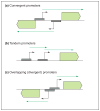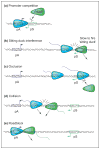Transcriptional interference--a crash course
- PMID: 15922833
- PMCID: PMC2941638
- DOI: 10.1016/j.tig.2005.04.009
Transcriptional interference--a crash course
Abstract
The term "transcriptional interference" (TI) is widely used but poorly defined in the literature. There are a variety of methods by which one can interfere with the process or the product of transcription but the term TI usually refers to the direct negative impact of one transcriptional activity on a second transcriptional activity in cis. Two recent studies, one examining Saccharomyces cerevisiae and the other Escherichia coli, clearly show TI at one promoter caused by the arrival of a transcribing complex initiating at a distant promoter. TI is potentially widespread throughout biology; therefore, it is timely to assess exactly its nature, significance and operative mechanisms. In this article, we will address the following questions: what is TI, how important and widespread is it, how does it work and where should we focus our future research efforts?
Figures


References
-
- Rojo F. Mechanisms of transcriptional repression. Curr Opin Microbiol. 2001;4:145–151. - PubMed
-
- Delaval K, Feil R. Epigenetic regulation of mammalian genomic imprinting. Curr Opin Genet Dev. 2004;14:188–195. - PubMed
-
- Wassarman KM. RNA regulators of transcription. Nat Struct Mol Biol. 2004;11:803–804. - PubMed
-
- Kuhn EJ, Geyer PK. Genomic insulators: connecting properties to mechanism. Curr Opin Cell Biol. 2003;15:259–265. - PubMed
Publication types
MeSH terms
Grants and funding
LinkOut - more resources
Full Text Sources
Other Literature Sources
Molecular Biology Databases

